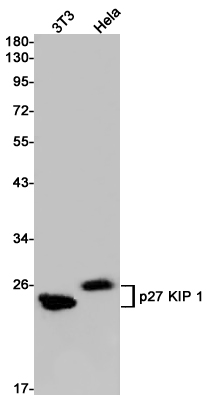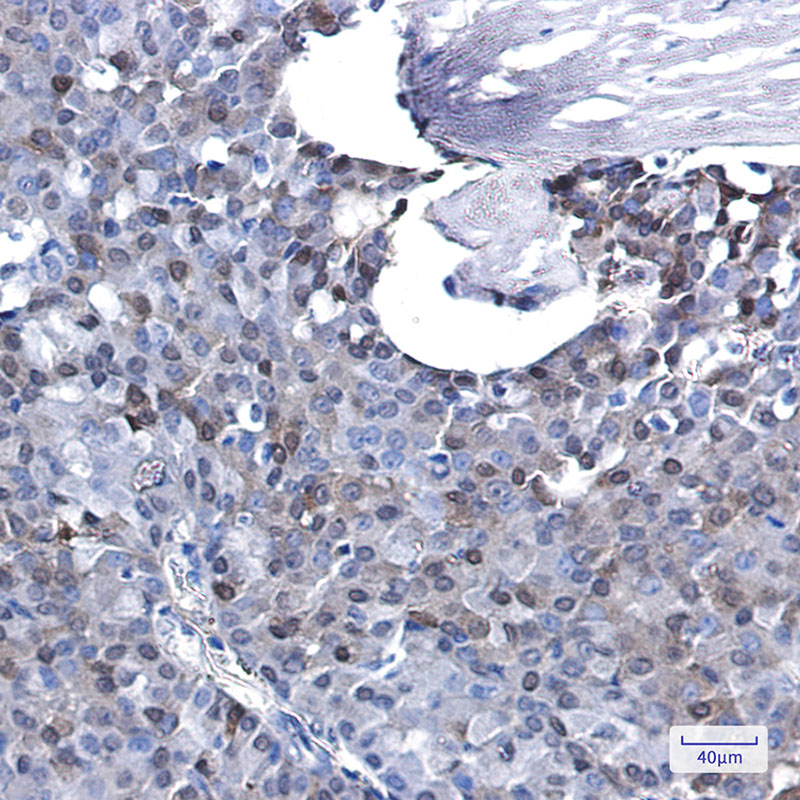

| WB | 1/500-1/1000 | Human,Mouse,Rat |
| IF | 1/20 | Human,Mouse,Rat |
| IHC | 1/50-1/100 | Human,Mouse,Rat |
| ICC | 技术咨询 | Human,Mouse,Rat |
| FCM | 咨询技术 | Human,Mouse,Rat |
| Elisa | 咨询技术 | Human,Mouse,Rat |
| Aliases | CDKN1B; KIP1; Cyclin-dependent kinase inhibitor 1B; Cyclin-dependent kinase inhibitor p27; p27Kip1 |
| Entrez GeneID | 1027 |
| WB Predicted band size | Calculated MW: 22 kDa; Observed MW: 27 kDa |
| Host/Isotype | Rabbit IgG |
| Antibody Type | Primary antibody |
| Storage | Store at 4°C short term. Aliquot and store at -20°C long term. Avoid freeze/thaw cycles. |
| Species Reactivity | Human,Mouse,Rat |
| Immunogen | A synthetic peptide of human p27 KIP 1 |
| Formulation | Purified antibody in TBS with 0.05% sodium azide,0.05%BSA and 50% glycerol. |
+ +
以下是3篇关于p27 Kip1抗体的代表性文献,简要总结如下:
---
1. **文献名称**: "p27. a novel inhibitor of G1 cyclin-Cdk protein kinase activity, is related to p21"
**作者**: Toyoshima, H., Hunter, T.
**摘要**: 该研究首次克隆并鉴定了p27 Kip1蛋白,证明其通过抑制cyclin E-CDK2复合物的活性调控细胞G1期进程。研究中利用特异性抗体证实p27与CDK2的结合及其在细胞周期阻滞中的作用。
---
2. **文献名称**: "Decreased levels of the cell-cycle inhibitor p27Kip1 in epithelial hyperplasia and carcinoma of the breast"
**作者**: Catzavelos, C., et al.
**摘要**: 通过免疫组化分析乳腺癌组织,发现p27 Kip1蛋白表达水平降低与细胞增殖和恶性程度相关。研究使用p27抗体揭示了其在癌症预后评估中的潜在价值。
---
3. **文献名称**: "Role of the ubiquitin-proteasome pathway in regulating abundance of the cyclin-dependent kinase inhibitor p27"
**作者**: Pagano, M., et al.
**摘要**: 阐明了p27 Kip1通过泛素-蛋白酶体途径降解的机制,研究利用抗体进行Western blot和免疫沉淀实验,证明其在细胞周期再进入中的动态调控作用。
---
4. **文献名称**: "Subcellular localization of p27kip1 expression predicts poor prognosis in non-small cell lung cancer"
**作者**: Kossatz, U., et al.
**摘要**: 通过免疫荧光和免疫组化技术,发现p27 Kip1的胞质定位(而非核定位)与肺癌患者不良预后显著相关,提示其亚细胞分布具有临床意义。
---
以上文献均为真实研究,涉及p27 Kip1抗体的实验应用,涵盖基础机制到临床关联分析。
p27 Kip1 (also known as CDKN1B) is a cyclin-dependent kinase (CDK) inhibitor that plays a critical role in regulating cell cycle progression at the G1-to-S phase transition. It functions by binding to and inhibiting cyclin-CDK complexes, particularly cyclin E-CDK2 and cyclin D-CDK4/6. thereby preventing phosphorylation of retinoblastoma (Rb) protein and blocking cell cycle progression. p27 is regulated through transcriptional, translational, and post-translational mechanisms, including phosphorylation-dependent degradation via the ubiquitin-proteasome system. Reduced p27 expression or mislocalization is frequently associated with cancer progression and poor prognosis, highlighting its tumor-suppressive role.
The p27 Kip1 antibody is a widely used tool in biomedical research to detect and quantify p27 protein levels in various experimental models. It is employed in techniques such as Western blotting, immunohistochemistry (IHC), immunofluorescence (IF), and flow cytometry to study cell cycle regulation, differentiation, and oncogenic processes. Researchers utilize this antibody to investigate p27's interaction with CDKs/cyclins, its subcellular localization (nuclear vs. cytoplasmic), and post-translational modifications (e.g., phosphorylation at Thr157/Thr198). Commercially available p27 antibodies are typically raised against specific epitopes of human p27. with cross-reactivity validated in multiple species. Proper validation, including knockout controls, is essential due to potential cross-reactivity with other CDK inhibitors like p21 or p57. Its applications extend to cancer research, drug discovery, and studies of cellular senescence or quiescence.
×